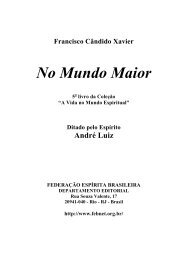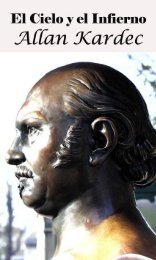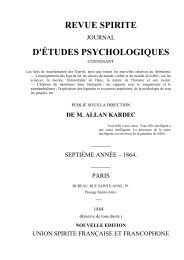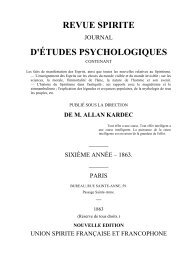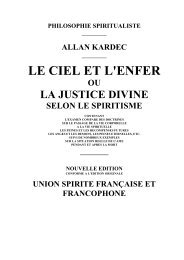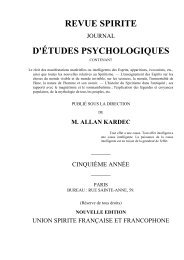PDF version - Geae
PDF version - Geae
PDF version - Geae
You also want an ePaper? Increase the reach of your titles
YUMPU automatically turns print PDFs into web optimized ePapers that Google loves.
CHAPTER XVII<br />
SUCCESSIVE LIVES - HISTORIC PROOFS<br />
Our studies would be incomplete if we did not cast a glance across the role which a belief in<br />
successive lives has played in history. This belief dominates all history, and we find it in the greatest religions<br />
of the Orient and in the most elevated philosophies. It has guided civilizations on their march, and has been<br />
perpetuated from age to age. In spite of persecutions and temporary eclipses, it reappears and persists across<br />
the centuries and in all countries. From India it spread over the world, and long before the great revelations of<br />
historic times, it was formulated in the Vedas, and notably in the Bhagavad Gita. Brahmanism and Buddhism<br />
are inspired with it, and Egypt and Greece adopted this same doctrine. Under symbols more or less obscure,<br />
everywhere it appears. It was known to the Roman world, and was the belief of Pythagoras, of Socrates, of<br />
Plato, Apollo, and Empedocles. Ovid, Virgil, and Cicero, in their imperishable works, make frequent allusions<br />
to it. Virgil, in the Aeneid, speaks of the soul plunging into Lethe, and losing memory of former lives. The<br />
school of Alexandria gave it great éclat, by the works of Philon, Plotinus, Ammonius, Saccas, etc. The sacred<br />
books of the Hebrews, the Zahar and the Kabala, affirm pre-existence, and under the name of resurrection,<br />
reincarnation. It was the belief of the Pharisees and Essenes. The old and the new Testaments, in the midst of<br />
obscure and altered texts, contain numerous traces of it - for example, in certain passages of Jeremiah; and in<br />
Jesus’ own words concerning John the Baptist, Mathew, chapter XI, ‘And if ye will receive it, this is Elias<br />
which was for to come.’ Also chapter XVII, ‘But I say unto you, that Elias is come already, and they knew<br />
him not, but have done unto him whatsoever they listed. Likewise shall the Son of man suffer of them. Then<br />
the disciples understood that he spoke unto them of John the Baptist.’ Primitive Christianity possessed, then,<br />
the true idea of destiny. But with the subtlety of Byzantine theology, the hidden sense disappeared little by<br />
little, and the virtue of secret rites of initiation vanished like a delicate perfume. Scholasticism smothered the<br />
first revelations under the weight of syllogisms, or ruined it by specious arguments.<br />
Nevertheless, the first fathers of the Church, and above all, Origen and Clement of Alexandria,<br />
pronounced in favor of the transmigration of souls. Origen, in his work called Principles, speaks of the preexistence<br />
and survivance of souls in other bodies. Saint Gregory of Nyssa said that it was a necessity of nature<br />
for the immortal soul to be cured and purified, and if it is not done here and now it must be done in the future<br />
lives. But in place of this simple and clear conception of destiny, an ensemble of dogmas was given to the<br />
world by scholasticism, revolting to the reason and separating man from God.<br />
The doctrine of successive lives reappears again at different epochs in the Christian world under the<br />
forms of great heresies and secret schools. But it was often drowned in blood and smothered under the ashes<br />
of funeral pyres. In the Middle Ages it was almost wholly eclipsed, and ceased to influence the Occidental<br />
thought, to its great detriment. From this came the errors and confusion of this somber epoch, the cruel<br />
persecution, the prison of the human spirit. A sort of intellectual night fell upon Europe. However, from afar<br />
came a ray of light, an inspiration from on high, illuminating some intuitive souls, and this doctrine remained<br />
for the deep thinkers the only possible explanation of the profound mystery of life.<br />
Not only the troubadours in their poems and chants made allusions to it, but powerful minds like<br />
Bonaventura and Dante Alighieri mentioned it in a formal fashion. Ozanam, a Catholic writer, recognized the<br />
plan of the Divine Comedy as following closely the great lives of antique initiation based on the plurality of<br />
lives. Cardinal Nicholas de Cuza sustained in the Vatican the theory of many lives and inhabited worlds with<br />
the consent of Pope Eugene IV. Thomas Moore, Paracelsus, Jacob Bochme, Giordano Bruno, Campanello,<br />
affirmed or taught the grand truth, often to their cost. Van Helmont, in De revolutione Animarum, gave in two<br />
hundred problems arguments in favor of the reincarnation of souls. Are not these superior intelligences<br />
comparable to the summits of the Alps which are the first to receive the fires of the day, and which conserve<br />
them when the rest of the earth is plunged in night? Philosophy in the late centuries is enriched with this<br />
doctrine. Cudworth and Hume considered this theory of immortality the most rational. Lessing, Hegel, Herder,<br />
Schelling, Fichte the younger, discussed it with elevation. Mezzini, in his work Del Concílio a Dio, said: ‘We<br />
believe in an indefinite series of reincarnations, each one of which constitutes a progress on the preceding: we<br />
can recommence the state where we left off, not meriting to pass to a superior one, but we cannot retrograde or<br />
perish.’<br />
84



